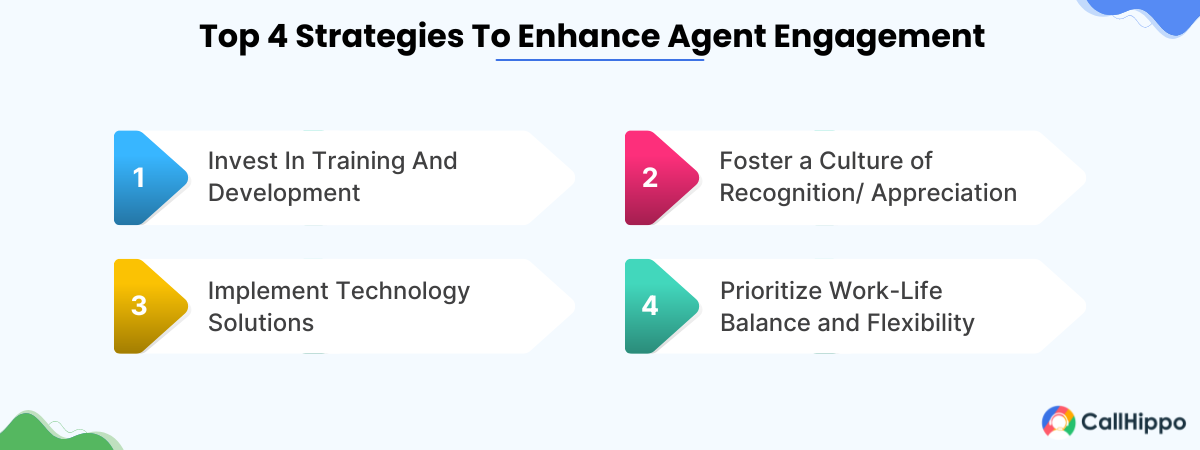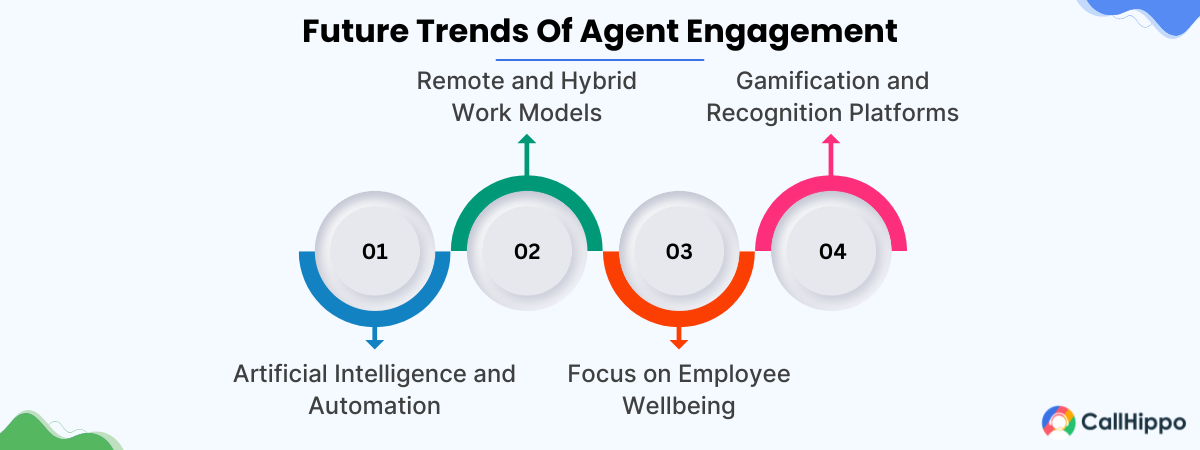In today’s customer-centric world, engaged agents are the backbone of exceptional service.
But how do you create a team of agents who are motivated, productive, and consistently deliver stellar service? Thus, the answer lies in agent engagement.
92% of executives believe that employee engagement plays a pivotal role in establishing high customer satisfaction, reducing employee turnover, and enriching overall business performance.
Let us understand the various strategies and methods to measure employee engagement, the challenges it involves, and future trends shaping the prospect of agent engagement.
Don't just track metrics—turn those metrics into a game! Implement points, leaderboards, and friendly competition for KPIs like first-call resolution or positive customer experience. A little healthy competition can boost motivation, celebrate achievements, and make work more fun!
What is Agent Engagement?
Agent engagement is a composite concept that describes the strength of the mental and emotional connection employees feel towards their work, their team, and their organization. It’s about how invested and enthusiastic employees are in their roles and the overall success of the company.
Highly engaged employees show a high level of dedication, are more productive, and contribute to the culture of the organization. They are genuinely interested in what they do and driven to help the company succeed, not just working for the next pay raise or promotion.
Employee engagement hinges on 3 factors and 3 associated questions.
- Work engagement: How much of a connection do I have with the work I do?
- Team engagement: What connections do I have with my team members?
- Organizational engagement: How much am I connected with the organization as a whole?

Strategies for Enhancing Agent Engagement
Engaged agents express a strong sense of purpose and passion, and they actively invest in their work.
Agents are prone to deliver outstanding customer service, offer creative ideas, and push the extra mile to satisfy their clients. Here are the four key strategies for improving agent engagement:

1. Invest In Training And Development
Knowledge is power! Providing ongoing training opportunities empowers agents with the skills and expertise to handle complex inquiries confidently.
Initial training should cover essential aspects such as product knowledge, customer service techniques, and company policies.
This foundational training ensures agents are well-prepared to handle customer inquiries and challenges from day one. An organization should include training modules such as:

2. Foster a Culture of Recognition/ Appreciation
Acknowledging and celebrating agent achievements goes a long way. Implement a system for recognizing top performers, positive customer feedback, or exceeding call center KPIs.
Encourage high-performing agents to take on mentorship roles or lead special projects. This not only recognizes their capabilities but also helps in their career development.
Employers can create a positive work environment by celebrating and offering:
- Employee of the Month
- Performance-Based Bonuses
- Gift Cards and Vouchers
- Personalized Thank-You Notes
- Spot Awards
- Recognition Events
- Peer Recognition Programs
3. Implement Technology Solutions
If your company has a great culture that supports open and honest communication but does not use collaboration tools for the teams to connect, then it’s of no use.
Identify what kind of technology your contact center requires to promote engagement, productivity, and effectiveness.
These technologies allow staff members to engage and communicate in methods other than emails and phone conversations— especially when you have onboarded remote contact center agents.
4. Prioritize Work-Life Balance and Flexibility
Burnout is a real threat to agent engagement. Therefore, offering flexible scheduling options, remote working opportunities if possible, and encouraging breaks throughout the workday will ensure that agents are well-rested and motivated to deliver their best performance.
Organizations should provide ample paid time off for vacations, personal days, and mental health days. Moreover, companies should offer access to mental health resources, such as counseling services, stress management workshops, and mental health days.
This support can help agents manage stress and maintain a healthy work-life balance.
With CallHippo AI
- Talk-to-listen Ratio
- Sentiment Analysis
- Call Performance Score

How To Measure Agent Engagement?
A precise evaluation of engagement levels is vital for determining the success of strategies that are intended to improve employee engagement. Here are four ways in which you can measure agent engagement:
https://webcdn.callhippo.com/blog/wp-content/uploads/2024/07/methods-to-measure-agent-engagement.png
1. Employee Satisfaction Surveys
To measure worker engagement, regularly conduct anonymous surveys to gauge employee satisfaction and identify areas for improvement.
Include questions about job satisfaction, work environment, and management support, such as;
- Satisfaction with current role and responsibilities
- Work-life balance and flexibility
- Support for personal growth and career aspirations
- Satisfaction with salary and bonuses
- Fairness and transparency in rewards and promotions
- Relationships with colleagues and team members
- Satisfaction with technology and equipment
Analyzing these surveys allows you to understand agent sentiment and tailor initiatives to address their needs and concerns. Additionally, create a feedback loop where agents can see how their feedback has led to positive changes, fostering a culture of continuous engagement.
2. Employee Turnover Rates
High turnover rates are a red flag for low agent engagement. Track turnover trends and analyze exit interviews to understand why agents are leaving.

Thus, understanding these reasons can help develop agent retention strategies and improve engagement.
3. Feedback Mechanisms
Building robust feedback systems allows agents to freely express their ideas and concerns.
This can include regular one-on-one meetings with supervisors, suggestion boxes, or anonymous feedback platforms.
Actively listening to and addressing agents’ feedback can lead to higher engagement and a more satisfied workforce.
4. Performance Metrics
While traditional KPIs like call duration and average handle time (AHT) are important, they don’t always show a complete picture.
Consider metrics like First Call Resolution (FCR) and Customer Effort Score (CES), which can indicate the quality and efficiency of agent interactions, often linked to higher engagement.
High engagement levels often correlate with better performance metrics. Thus, by tracking these indicators, organizations can identify trends and areas where agents might need additional support or training.
What Are The Challenges in Maintaining Agent Engagement?
Maintaining agent engagement comes along with certain obstacles. Here are four common challenges that organizations face:
1. Repetitive and Monotonous Work
Certain customer service interactions might become repetitive over time. Moreover, agents often deal with high workloads and stressful situations, which can lead to burnout and disengagement.
Thus, managing workload effectively and providing support through team collaboration and mental health resources can help mitigate this challenge.
2. Lack of Career Development Opportunities
Inadequate career development can significantly hinder agent engagement, leading to dissatisfaction, high turnover rates, and reduced productivity. Sometimes, the agents’ career aspirations may go unrecognized or unaddressed, leading to frustration and a lack of engagement.

Therefore, organizations should provide personalized career development plans so that agents have a clear roadmap for their professional growth and advancement.
3. Technological Challenges
Time spent troubleshooting technical issues is time taken away from providing excellent customer service. Constantly battling technology can make it difficult for agents to focus on what matters most—the customer at hand, declining both engagement and satisfaction.
Hence, invest in user-friendly and reliable technology solutions that empower agents to efficiently handle customer inquiries.
4. Poor Communication
When instructions and expectations are not clearly communicated, agents can become confused about their roles and responsibilities. Thus, poor communication can severely impact agent engagement, leading to misunderstandings, reduced agent productivity, and low morale.
However, using multiple communication channels like team meetings, instant messaging, and collaboration tools will ensure that messages are effectively conveyed and received.
The Future of Agent Engagement
The future of agent engagement is likely to be shaped by several emerging trends:

1. Artificial Intelligence and Automation
AI and automation will continue to transform customer service, allowing agents to focus on more complex tasks and improving overall job satisfaction. This shift will also increase the adoption of advanced tools such as AI BDR solutions, which can automate routine outreach and free agents to focus on relationship-building.
2. Remote and Hybrid Work Models
Remote and hybrid work models are becoming increasingly popular. Therefore, companies will need to develop strategies to maintain team cohesion and engagement in a decentralized environment.
3. Focus on Employee Well-being
Employee well-being will be a top priority in the upcoming generation. Companies will invest in initiatives that promote mental and physical health, creating a positive work environment that fosters long-term engagement.
4. Gamification and Recognition Platforms
Gamification elements can motivate agents by presenting tasks as challenges and rewarding accomplishments. Hence, in the coming years, recognition platforms will provide real-time feedback and social recognition, fostering a culture of appreciation.
Final Thoughts
For a business to succeed, fostering a highly engaged agent staff is fundamental. Organizations can benefit from call center agents’ engaged workflow by putting comprehensive strategies into effect to foster continual learning, establish a supportive atmosphere, and motivate agents.
Adding to this, understanding the challenges and staying on top of future trends to improve agent engagement will be critical for maintaining a motivated and productive customer service team.
FAQs
1. What are the 4 P’s of engagement?
The 4 P’s of engagement are Place, Price, Product, and Promotion.
2. What is call center agent engagement?
Engagement in a call center refers to the level of commitment, enthusiasm, and motivating agents toward their roles. High engagement leads to better agent performance, lower turnover, and higher customer satisfaction.
3. What are the four types of customer engagement?
The four types of customer engagement are Emotional, Rational, Active, and Passive. Feelings drive emotional engagement, Rational engagement is based on logical reasoning, Active engagement involves proactive participation, and Passive engagement occurs when customers are influenced by their environment without active involvement.

Subscribe to our newsletter & never miss our latest news and promotions.









